Photographs: Reuters
Nothing changed the world as much as did the Internet. It revolutionised communication across the world and transformed it into a global village.
Here are a few interesting facts about the wonder called Internet:
- There are a total of 1.8 billion Internet users in the world.
- There are 32 countries with more than 10 million Net users.
- China together with the United States make up half of the Net users in the world.
- Out of the top 20 countries, the five with the highest Net penetration (not users) are: United Kingdom (82.5%), South Korea (81.1%), Germany (79.1%), Japan (78.2%), United States (76.3%).
- Seven out of the top 20 countries are Asian (35%).
- Five out of the top 20 countries are European (25%). Six (30%) if you also count Russia.
- Three of the top 20 are English-language countries (four if you count India).
These facts raise the obvious question: which are the top 20 nations as far as Internet usage is concerned? internetworldstats.com recently came up with a list.
Click NEXT to know more about these countries. . .
Internet users: Top 20 countries
Photographs: Reuters
Rank 1: China; 420 million Internet users
Despite the controversies that Google faced in China, the country leads as far as Internet users are concerned.
On September 20, 1987, China's first Net connection was established between Beijing and Karlsruhe University in Germany.
The first e-mail went out on September 14, 1987 with the message 'Across the Great Wall, we can reach every corner in the world'.
It is projected that China's Internet population will reach 469 million by the end of 2010, and the number will hit 718 million by 2013.
. . .
Internet users: Top 20 countries
Image: A protester calling for immigration law reform waves a US flag during a rally at Washington Mall.Photographs: Jason Reed/Reuters
Rank 2: United States; 239 million Internet users
In the United States, it all started in the late 1960s, when Defense Advanced Research Projects Agency developed a project called the ARPANET (Advanced Research Projects Agency Network).
The Internet, which grew out of this initial project, first gained a public face in the 1990s.
By 2004, three quarters of Americans had Internet access at home, and by June 2010 total number of Internet users stands 234.4 million.
Interestingly, in 2008, the United States ranked 15th out of 30 countries in broadband penetration rates.
This low worldwide ranking is surprising to many, as the Internet itself was invented in the United States.
The country ranked behind most other developed nations, including the UK, Germany, France, Denmark, Switzerland, and Canada.
. . .
Internet users: Top 20 countries
Photographs: Reuters
The Washington Post in a report once wrote, 'Americans invented the Internet, but the Japanese are running away with it.'
Japan has the world's third fastest Internet connections (7.8 Mbps), delivering more data at a lower cost than almost anywhere else.
The speed advantage allows the Japanese to watch broadcast-quality, full-screen television over the Internet, an experience that mocks the grainy, wallet- size images Americans endure, WSJ wrote.
Overcoming the substantial barriers erected by the Japanese government to the introduction of the Internet, promoters and entrepreneurs managed to create an flexible and dynamic Internet society.
From a slow start, Japan has emerged as the global leader in the mobile Internet.
. . .
Internet users: Top 20 countries
Photographs: Reuters
Rank 4: India; 81 million Internet users
Internet in India was established more than a decade ago as ERNET -- Educational Research Network.
It was a joint undertaking of the Department of Electronics of the Government of India, and the United Nations Development Program.
On August 15 1995, Videsh Sanchar Nigam Limited launched the Gateway Internet Access Service.
In 1998, India introduced new Internet Service Provider policy which ended Videsh Sanchar Nigam Limited's monopoly on Internet.
. . .
Internet users: Top 20 countries
Image: Sao Paulo.Rank 5: Brazil; 75 million Internet users
The Internet was launched in Brazil in 1988, when the now defunct National Research Network was formed by the academic communities of Rio de Janeiro and Sao Paulo.
It was introduced to the general public, in 1995. Brazilian Internet depended strongly on efforts led by the Federal government and the state-owned communications company Embratel and its holding, Telebras.
This changed in 1998, as a result of the privatisation of Telebras, and the blossoming of private groups such as Telefonica, Telemar and Brasil Telecom.'
. . .
Internet users: Top 20 countries
Image: The historic Reichstag building in Berlin.Photographs: Reuters
Rank 6: Germany; 65 million Internet users
Competition in the Internet market in Germany is intense and, like all areas of the telecom market, there is a wide range of companies offering services and promotional rates to customers.
High speed Internet access is best through a DSL connection and there are many options for telephone and Internet packages.
Most towns and cities have Internet cafes and Internet 'hotspots' providing access via laptop or short-range wireless LAN.
Using the Internet to make telephone calls (Voice over Internet Protocol or VoIP) is gradually becoming more popular in Germany.
. . .
Internet users: Top 20 countries
Image: Fireworks at Red Square, Moscow.Rank 7: Russia; 59 million Internet users
It all started in january 1990 with the creation of the social organisation Glasnet (Glasnost + Network).
The name and funding was provided by San Francisco-based Association for Progressive Communication.
IT provided grants, which financed Internet work for teachers, human rights workers, ecologists, informal groups and other guarantors of the open society.
In 1993, Glasnet became a commercial provider.
Russia still has some e-addresses that have existed since 1991, which were among the first 150 Russian (or, rather, Soviet) electronic addresses.
In 1994 Russia opened its first website - Moscow Libertarium.
It is one of the oldest sites on the Russian Internet and is supposed to be among the first 3,000 WWW sites in the world.
. . .
Internet users: Top 20 countries
Photographs: Reuters
Rank 8: United Kingdom; 62 million Internet users
Broadband Internet access in the UK was, initially, provided by a large number of regional Cable television and telephone companies which gradually merged into larger groups.'
More than half of UK homes have broadband.
Currently Internet access is available to businesses and home users in various forms, including dial-up, cable, DSL, and wireless.
. . .
Internet users: Top 20 countries
Image: The Eiffel Tower, Paris.Rank 9: France; 44 million Internet users
France has several high-speed/DSL ISPs which all offer more or less the same deal: unlimited Internet, TV, and telephone (with free calls to fixed phones in dozens of countries) for about euro 30 per month.
In February this year, the lower house of the French parliament approved a draft bill that will allow the state unprecedented control over the Internet.
Although the government said it will improve security for ordinary citizens, civil rights activists warned of a 'new level' of censorship and surveillance.
. . .
Internet users: Top 20 countries
Photographs: Reuters
Rank 10: Nigeria; 43 million Internet users
How many Nigerian scam mails do you receive in a week? Innumerable would probably your answer.
However, ICT experts of the country are concerned about Nigeria's disinterest in the Internet.
They feel the country needs massive, cheap high speed Internet to further progress and improve access to connectivity.
While the global average broadband penetration is 30 per cent, in Nigeria broadband has a little penetration of one per cent out of the estimated seven per cent of Internet access.
. . .
Internet users: Top 20 countries
Photographs: Reuters
Rank 11: South Korea; 39 million Internet users
South Korea leads in the number of Digital Subscriber Line connections per head worldwide.
South Korea's broadband network is the fastest.
Seoul, the nation's capital, has been called 'the bandwidth capital of the world'.
In 2005 96.8 per cent of South Korean mobile phones had Internet access.
In January 2006, it became the first country to achieve over 50 per cent broadband penetration per capita.
The Internet has a higher status for many Koreans than it does in the West.
. . .
Internet users: Top 20 countries
Photographs: Reuters
Rank 12: Turkey; 35 million Internet users
Turkey has Internet access since 1993, although experimentation at Ege University started in 1987.
The first available connections were dial-up.
After June 2009, 3G Mobile Networks got approval from Ministry of Transport and Communications.
Price policies of the cellular network companies in the country are almost same with the broadband companies.
. . .
Internet users: Top 20 countries
Photographs: Reuters
Rank 13: Iran; 33 million Internet users
Origin of Internet in Iran dates back to 1987.
The Internet then was also called ARPANET.
It was a project supported by the Defense Advanced Projects Agency connecting various academic and defense research centers in the US.
This network supported only email and simple data transfer.
However, in 1993, Iran became the second country in West Asia to be connected to the Internet, and since then the government has made significant efforts to improve the nation's ICT infrastructure.
Iran's national Internet connectivity infrastructure is based on two major networks: the public switched telephone network and the public data network.
. . .
Internet users: Top 20 countries
Photographs: Reuters
Rank 14: Mexico; 30.6 million Internet users
Mexico is the country with the most Internet users among Spanish speaking counties in the western hemisphere.
In August 2005, Cisco Systems said they see Mexico and countries in Latin America as the focal point for growth.
Telmex has a de-facto monopoly in providing Digital Subscriber Line connectivity.
It is also one of Latin America's countries that have no Internet censorship.
. . .
Internet users: Top 20 countries
Image: A busy street in Rome.Rank 15: Italy; 30 million Internet users (30,026,400)
Currently, Internet access in Italy is available to businesses and home users in various forms, including dial-up, cable, Digital Subscriber Line, fibre to the home, mobile, wireless and satellite.
However, lack of funding to improve and maintain the Italian phone network has made it incomplete and outdated.
In 2009, Broadband Internet access reached 18.1 per cent of the Italian population and 31 per cent of Italian homes had Broadband Internet Access.
Computerisation is slow in Italy.
Only 15 per cent Italians use Internet for online banking or e-government services.
. . .
Internet users: Top 20 countries
Photographs: Reuters
Rank 16: Indonesia; 30 million Internet users (30,000,000)
Several internet services are available in Indonesia, ranging from Asymmetric Digital Subscriber Line to mobile Internet.
Telephone line-based Internet service was among the first Internet service in Indonesia with PT Telkom as a main player who controls most fixed telephone line networks.
Internet charge in Indonesia was among the highest in the world in 2007.
According to a Nielsen's Company survey, 48 per cent of Internet users in Indonesia used a mobile phone to access the Internet, whereas 13 per cent used other handheld multimedia devices.
. . .
Internet users: Top 20 countries
Image: Employees at a call centre in Manila.Photographs: Joseph Agcaoili/Reuters
Rank 17: Philippines; 29.7 million Internet users
The Internet arrived in Philippines in March 1994.
Then Philippine Network Foundation connected the country and its people to Sprint in the United States via a 64-kbps link.
The growth of the Internet in the Philippines was hindered by many obstacles, including unequal distribution of the Internet throughout the country, its cost and corruption in the government.
In the Philippines, broadband Internet is usually available to consumers through cable and Digital Subscriber Line.
. . .
Internet users: Top 20 countries
Photographs: Reuters
Rank 18: Spain; 29 million Internet users
Asymmetric Digital Subscriber Line arrived in Spain in 1999. The main ISPs are:- Telefonica
- Direct Telecom
- Vodafone
- Ya.com
- Orange
- Tele2
- Jazztel
- Ono
The average speed is 4 mbit/s, costing Euro25 to Euro50 per month for an unmetred line.
. . .
Internet users: Top 20 countries
Image: Children watching a match in Argentina.Photographs: Reuters
Rank 19: Argentina; 26.6 million Internet users
Besides monthly-paid Internet connections (either flat rate or with a number of free minutes), Argentina has a number of Internet service providers that have commercial agreements with the telephone companies for charging a slightly higher communication rate to the user for that communication.
There were over 7 million personal computers registered in Argentina in March 2008.
The number of dial-up users has decreased drastically since 2005 in favour of broadband Internet access.
. . .
Internet users: Top 20 countries
Image: The Olympic Torch in Vancouver.Photographs: Courtesy, City of Vancouver website.
Rank 20: Canada; 26.2 million Internet users
Fifty three point 6 per cent of Canadians connect to the Internet using a type of high-speed connection.
The most popular sites in Canada are the major international ones, such as Google, Yahoo!, and MSN.
Canada has the greatest number of file sharers per capita in the world according to a report by the Organization for Economic Cooperation and Development.

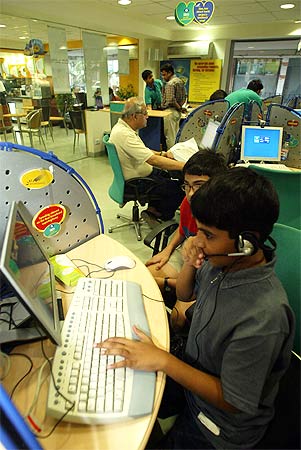




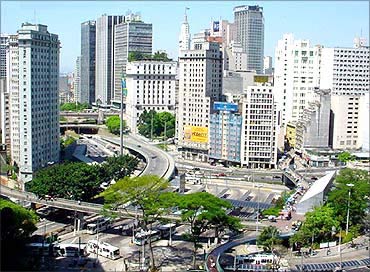
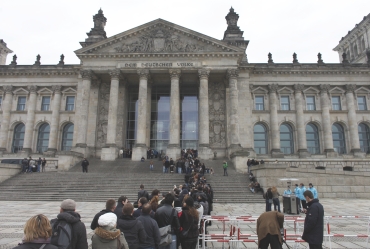


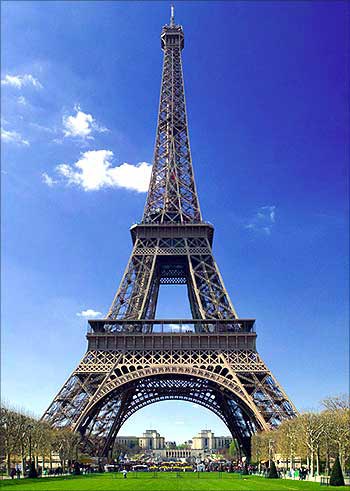
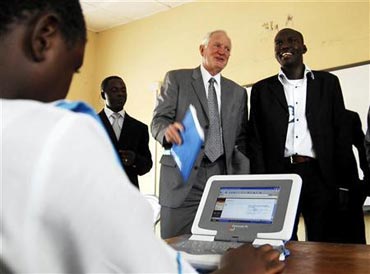

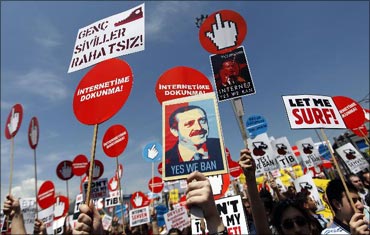
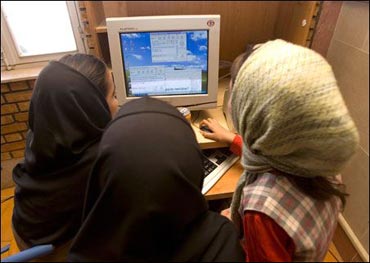
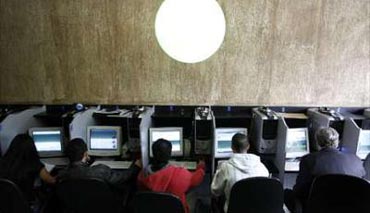



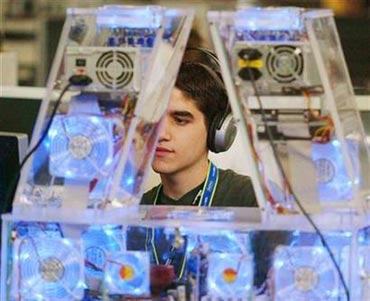


article